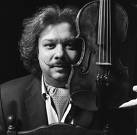
Violinist Roby Lakatos has made Belgium his home, but as Paul Stump finds out, he's a world citizen
The bustling ambiance of the bar at the Hotel Metropole is all wrong for the surprisingly soft-spoken gypsy violinist Roby Lakatos. Given his promiscuous virtuosity onstage, his reticence is almost incongruous.
Lakatos is packaged as a kind of dandified teddy-bear, in clothes that might charitably be described as 'rococo', a sumptuously coiffed head seemingly too big for his body and a moustache waxed to within an inch of its life. But I still have to encorage him to raise his voice.
"You know what?" he says with a twinkle in his brown eyes, "I did that whole image bit for a laugh. My manager and record company said, 'that's it!' and I've used the whole thing ever since!"
Not that he needs an image to impress. He's the seventh generation in a family of violinists traceable to virtuoso Laszlo Bihari, whose playing bewitched the court of Habsburg Emperor Franz-Josef. Bihari's mesmerising marriage of gypsy fiddle voicings and traditional Hungarian dances - most notably the csardas, a two-step variant of older Carpathian and Transylvanian dances - inspired Liszt and Brahms.
At first a classical violin student, Lakatos was a prize-winner at Budapest's Bela Bartok Conservatory in 1984 before trying his luck in the west. "It was easier getting to and from Hungary than any other Eastern Bloc country back then," he remembers. "I was with a gypsy band in Liège, liked the place, so I was able to stay and still visit Budapest. Now I think of myself as Belgian."
It's when Lakatos talks music that he truly comes alive. "I try to mix as many influences as I can. Jazz, folk, classical. Being nomadic, gypsy music and culture have always had to adapt to the local culture. Look at flamenco guitarists or Mariachi bands. These days, gypsy music all over the world is different. There can be differences beteween regiuons and even districts within a certain country."
So, he thought, why be constrained by one tradition? "Our violin tradition hadn't moved on fast enough. It was too heavily associated with kitsch, with hack musicians serenading diners over a plate of goulash." It's an enduring stereotype - the gypsy violinist as maudlin eulogiser of onion domes and ox-carts, the tears of exiles who've had too much paprika and Bull's Blood. This, though, isn't Lakatos's bag at all.
But by its very definition, gypsy music is always moving, evolving, transforming itself, I offer. "That's right. At first my family weren't happy with what I did, but then they accepted it. Hungarian gypsy music is full of influences. The Turks ruled Hungary for 500 years, so there's an Eastern influence, too. And look at the gypsy traditions in jazz. I played on one of Stéphane Grappelli's last dates, you know," he adds, with deserved pride.
At the Cirque Royal, Lakatos reveals another aspect of his musical buttwerfly mind - klezmer, another music of nomadic tonalities and rhythms, and featuring his manager, the Belgian singer Myriam Fuchs. "That'll be the next CD," declares Lakatos. "We're taking the music on the road before Christmas, and then recording."
Lakatos has known most of his sidemen for a good part of his adult life. "It's unusual for musicians to stick together like that," he says, "and even rarer for them to have such a good rapport on the bandstand."
Symphony orchestras and chamber dates have also comes Lakatos' way. Russian pianist Polina Leschenko has recorded a Prokofiev sonata with him on a session that included the great Argentinian pianist Martha Argerich. "I hadn't played classical music formally since I left Hungary two decades ago," confesses Lakatos. "But when a beautiful girl asks you to do something like that, you do it!" Another twinkle - of roguish gallantry this time.
But it's improvisation that clearly thrills Lakatos the most. "It's all about imagination. I went to see the latest Harry Potter movie when I was in Hollywood last week. Brilliant stuff! That's the sort of imagination a true improviser needs, no matter what kind of art. I love it when I improvise and the audience responds. The audience and me, ideally, we work off each other. The better they respond, the better I respond."
This article appeared in edited form in The Bulletin, 8.12.2005
1 comment:
Your blog keeps getting better and better! Your older articles are not as good as newer ones you have a lot more creativity and originality now keep it up!
Post a Comment